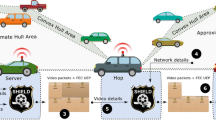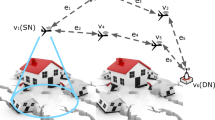Abstract
With the development of the Internet of Things, installation of smart mobile terminal in vehicle has become more and more popular, and consequently, how to provide services for the public utilizing vehicular ad hoc networks has aroused great interest in research and industrial areas. Among them, the kind of services supported by live video streaming attracts more attention because of its advantages. However, due to the high vehicular speed, frequent disconnection and dynamic topology, it’s difficult to guarantee the low-delay delivery of real-time video data, and there is hardly any scheme that can deliver such kind of data with satisfied quality. In this paper, we take fully advantage of the existing wireless enabled traffic cameras, and propose a novel traffic-camera assisted routing for video delivery, which can deliver live video stream to mobile target vehicle with minimal start-up delay while satisfying the required visual quality and playback performance through optimal buffering points selection and intelligent relay among them. The trace-driven simulations demonstrate that our strategy outperforms existing solutions greatly.















Similar content being viewed by others
Notes
Please note that we only focus on the kind of video data which is encoded using hybrid video codecs, such as MPEG-2 or H.264/AVC. This is meaningful because the vast majority of videos used commonly are encoded by this means.
Please note that this assumption is just to simplify the formulation, and in fact, there are several error-concealment algorithms on the decoder side, which can decode a frame with acceptable visual quality even if some packets are not delivered.
References
Guha, S., Plarre, K., et al. (2012). Autowitness: locating and tracking stolen property while tolerating gps and radio outages. ACM Transactions on Sensor Networks (TOSN), 8(4), 31.
Kim, D.H., Kim, Y., & Estrin, D. et al. (2010). Sensloc: sensing everyday places and paths using less energy. In Proceedings of the Conference on Embedded Networked Sensor Systems (SenSys) 2010, ACM.
Weppner, J., & Lukowicz, P. (2011). Collaborative crowd density estimation with mobile phones. In Proceedings of the Conference on Embedded Networked Sensor Systems (SenSys) 2011, ACM.
Schweizer, I., & Bärtl, R. et al . (2011). NoiseMap-real-time participatory noise maps. In Proceedings 2nd Intl Workshop on Sensing Applications on Mobile Phones (PhoneSense11), ACM.
Zhao, D., Ma, H., & liu, L. (2014). Energy-efficient opportunistic coverage for people-centric urban sensing. Wireless Networks, Springer, 20(6), 1461–1476.
Thiagarajan, A., & Biagioni, J. et al. (2010). Cooperative transit tracking using smart-phones. In Proceedings of the 8th ACM Conference on Embedded Networked Sensor Systems (SenSys) 2010, ACM.
Chen, J., Ma, H., & Zhao, D. (2015). Private data aggregation with integrity assurance and fault tolerance for mobile crowd-sensing. Wireless networks, Springer, Online: December 11 2015.
Koukoumidis, E., Peh, L. -S., Martonosi, M. R. (2011). SignalGuru: leveraging mobile phones for collaborative traffic signal schedule advisory. In Proceedings of the International Conference on Mobile Systems, Applications, and Services (MobiSys) 2011, ACM.
Lee, K., & Flinn, J. et al. (2013). AMC: Verifying user interface properties for vehicular applications. In Proceedings of the International Conference on Mobile Systems, Applications, and Services (MobiSys) 2013, ACM.
You, Chuang-Wen., & Lane, Nicholas D. et al. (2013). CarSafe App: Alerting Drowsy and Distracted Drivers using Dual Cameras on Smartphones. Proceedings of the International Conference on Mobile Systems, Applications, and Services (MobiSys) 2013, ACM.
Wang, Yin., & Liu, Xuemei. et al. (2013). CrowdAtlas: Self-updating maps for cloud and personal use. In Proceedings of the International Conference on Mobile Systems, Applications, and Services (MobiSys) 2013, ACM.
Wang, Y., & Yang, J. et al. (2013). Sensing vehicle dynamics for determining driver phone use. Proceedings of the International Conference on Mobile Systems, Applications, and Services (MobiSys) 2013, ACM.
Wu, H., & Fujimoto, R. et al. (2004). MDDV: a mobility-centric data dissemination algorithm for vehicular networks. In Proceedings of International Workshop on VehiculAr Inter-NETworking, Systems, and Applications (VANET) 2004, ACM.
Zhao, J., & Cao, G. (2006). VADD: Vehicle-assisted data delivery in vehicular ad hoc networks. In Proceedings of the International Conference on Computer Communications (INFOCOM) 2006, IEEE.
Skordylis, A., & Trigoni, N. (2008). Delay-bounded routing in vehicular ad-hoc networks. In Proceedings of the International Symposium on Mobile Ad Hoc Networking and Computing (MobiHoc) 2008, ACM.
Jeong, J., & Guo, S. et al. (2009). TBD: Trajectory-based data forwarding for light-traffic vehicular networks. In Proceedings of the International Conference on Distributed Computing Systems (ICDCS) 2009, IEEE.
Xu, F., & Guo, S. et al. (2011). Utilizing shared vehicle trajectories for data forwarding in vehicular networks. In Proceedings of the International Conference on Computer Communications (INFOCOM) 2011, IEEE.
Wu, Y., Zhu, Y., & Li, B. (2011). Trajectory improves data delivery in vehicular networks. In Proceedings of the International Conference on Computer Communications (INFOCOM) 2011, IEEE.
Naumov, V., & Gross, T. R. (2007). Connectivity-aware routing (CAR) in vehicular ad-hoc networks. In Proceedings of the International Conference on Computer Communications (INFOCOM) 2007, IEEE.
Ding, Y., Wang, C., & Xiao, L. (2007). A static-node assisted adaptive routing protocol in vehicular networks. In Proceedings of International Workshop on VehiculAr Inter-NETworking, Systems, and Applications (VANET) 2007, ACM.
Luan, T. H., & Cai, L. X. et al. (2011). VTube: Towards the media rich city life with autonomous vehicular content distribution. In Proceedings of the 8th Annual IEEE Communications Society Conference on ensor, Mesh and Ad Hoc Communications and Networks (SECON), IEEE.
Jeong, J., & Guo, S. et al. (2010). TSF: Trajectory-based statistical forwarding for infrastructure-to-vehicle data delivery in vehicular networks. In Proceedings of the International Conference on Distributed Computing Systems (ICDCS) 2010, IEEE.
Di, W., Zhang, Y., et al. (2013). Location-based crowdsourcing for vehicular communication in hybrid networks. IEEE Transactions on Intelligent Transportation Systems, 14(2), 837–846.
Wu, D., & Luo, J. et al. (2011). Geographic load balancing routing in hybrid vehicular ad hoc networks. In Proceedings of the 14th International IEEE Conference on Intelligent Transportation Systems (ITSC).
Guo, M., Ammar, M. H., & Zegura, E. W. (2005). V3: A vehicle-to-vehicle live video streaming architecture. Pervasive and Mobile Computing, 4(1), 404–424.
Masala, E., & De M., Juan C. (2007). Distortion-optimized retransmission for low-delay robust video communications over 802.11 intervehicle ad hoc networks. In Proceedings of International Workshop on VehiculAr Inter-NETworking, Systems, and Applications (VANET) 2007, ACM.
Guo, M., Ammar, M. H., & Zegura, E. W. (2012). A mobility-aware and quality-driven retransmission limit adaptation scheme for video streaming over VANETs. IEEE Transactions on Wireless Communications, 11(5), 1817–1827.
Soldo, F., & Casetti, C. et al. (2008). Streaming media distribution in vanets. In Proceedings of IEEE Gloabal Communications Conference (GLOBECOM) 2008, IEEE.
Yang, Z., Li, M., & Lou, W. (2010). Codeplay: Live multimedia streaming in vanets using symbol-level network coding. In Proceedings of the International Conference on Network Protocols (ICNP) 2010, IEEE.
Belyaev, E., Vinel, A., et al. (2015). Robust vehicle-to-infrastructure video transmission for road surveillance applications. IEEE Transactions on Vehicular Technology, 64(7), 2991–3003.
Richardson, I. E. (2004). H.264 and MPEG-4 video compression: video coding for next-generation multimedia. USA: Wiley.
Ziviani, A., Wolfinger, B. E., et al. (2005). Joint adoption of QoS schemes for MPEG streams. Multimedia Tools and Applications, 26(1), 59–80.
Conan, V., Leguay, J., & Friedman, T. (2007). Characterizing pairwise inter-contact patterns in delay tolerant networks. In Proceedings of the 1st international conference on Autonomic computing and communication systems, ICST (Institute for Computer Sciences, Social-Informatics and Telecommunications Engineering).
Gao, W., & Li, Q. et al. (2009). Multicasting in delay tolerant networks: A social network perspective. In Proceedings of the international symposium on Mobile ad hoc networking and computing (MobiHoc) 2009, ACM.
Papoulis, A. (1990). Probability & statistics. Englewood Cliffs: Prentice-Hall.
Wu, H., & Ma, H. (2013). DSVM: A buffer management strategy for video transmission in opportunistic networks. In Proceedings of the International Conference on Communications (ICC), IEEE.
T-Drive trajectory data sample. http://research.microsoft.com/apps/pubs/?id=152883
Acknowledgments
The research reported in this paper was supported by the National Natural Science Foundation of China under Grant No. 61332005; the Funds for Creative Research Groups of China under Grant No. 61421061; the Research Fund for the Doctoral Program of Higher Education of China under Grant No. 20120005130002; the Cosponsored Project of Beijing Committee of Education, and Beijing Training Project For The Leading Talents in S&T(ljrc201502); the Joint Funds of the National Natural Science Foundation of China (Grant No. U1404602,U1404615, U1404611); the Key Science and Research Program in University of Henan Province (16A460018); the Program for Science & Technology Innovation Talents in the University of Henan Province under Grant No. 16HASTIT035; Youth Science Foundation of Henan University of Science and Technology.
Author information
Authors and Affiliations
Corresponding author
Rights and permissions
About this article
Cite this article
Wu, H., Ma, H., Liu, L. et al. A traffic-camera assisted cache-and-relay routing for live video stream delivery in vehicular ad hoc networks. Wireless Netw 23, 2051–2067 (2017). https://doi.org/10.1007/s11276-016-1272-5
Published:
Issue Date:
DOI: https://doi.org/10.1007/s11276-016-1272-5




